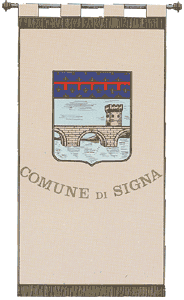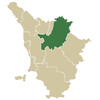|
 Inhabitants in 1991: 14.375
Inhabitants in 1991: 14.375
 The
municipal territory of Signa, in Valdarno Inferiore, extends for 18,81
square kilometres in plains and hills. It takes its origins from
a municipality in the Medieval era with modifications and additions.
Initially separated in the municipality of Gangalandi (Lastra a Signa).
Signa and Lecore in 1774 underwent a restructurisation when the
community of Signa and that of Lecore were united to that of Campi, until
in 1808 with a Napoleonic decree, Signa became elected a community
existing by itself. A royal decree of November 1928 assigned part of the
suppressed municipality of Brozzi to it. The
municipal territory of Signa, in Valdarno Inferiore, extends for 18,81
square kilometres in plains and hills. It takes its origins from
a municipality in the Medieval era with modifications and additions.
Initially separated in the municipality of Gangalandi (Lastra a Signa).
Signa and Lecore in 1774 underwent a restructurisation when the
community of Signa and that of Lecore were united to that of Campi, until
in 1808 with a Napoleonic decree, Signa became elected a community
existing by itself. A royal decree of November 1928 assigned part of the
suppressed municipality of Brozzi to it.
The main centre, or Roman origin (Exinea), placed at the influx
of the Bisenzio with the Arno, it was testified for the first time
as castle in 978; it is to be noted that along the whole course of
the Arno between Firenze and Pisa, Signa was the only centre which
possessed a bridge, attested to already before the XII century as
head of which on the left bank, and therefore opposite the original habitat
a centre had formed, whose name (market) left no doubt as to its function
(1252). Punto Nevralgico, therefore, with regard to the viability
it must not be forgotten that on the bank where the market was situated
passed the road to Pisa and a strategic centre of notable importance
in that it was situated on the borders of the Fiorentino county and
that of Pistoia. This situation was negative for Signa on some occasions,
like when in 1325 Castruccio Castracani after having destroyed the bridge
over the Arno set fire to the town. For the importance which we have mentioned
already in 1326 the municipality of Firenze had given permission for the
rebuilding of the castle (two of its gates are still visible) together
with the best part of the surrounding walls. The reconstruction of the
walls followed that of the bridge, and from then apart from isolated cases
(a siege of 1397) the town did not suffer other damage. The economic position
of Signa was prosperous and at the end of the XVIII century it was
recorded as the most populated country community of the Grand Duchy.
During the war the town and in particular the locality of Ponte a Signa
was badly damaged and, other than destroying the bridge which was reconstructed
further up stream, had 48% of its building destroyed.
Places to visit:
Castle, ancient nucleus formed
before the year 1000 surrounded by the ruins of the 1300 wall which
comprises also S. Maria in Castello, church already documented in
746 and remade several times over the centuries.
S. Giovanni
Battista, or della Beata, in the 1400 parish church is laid the
body of the blessed Giovanna da Signa. The three nave interior together
with other works of art preserves the mural with the History of
Blessed Giovanna carried out in two different epochs. |
Historical info reproduced upon authorization of Regione Toscana - Dipartimento della Presidenza E Affari Legislativi e Giuridici
Translated by Ann Mountford |